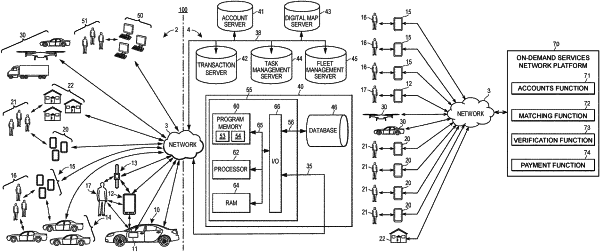| CPC G06Q 40/08 (2013.01) [G01C 21/3438 (2013.01); G01C 21/3605 (2013.01); G06Q 10/02 (2013.01); G06Q 10/04 (2013.01); G06Q 10/06315 (2013.01); G06Q 20/401 (2013.01); G06Q 30/0207 (2013.01); G06Q 50/30 (2013.01); G08G 1/202 (2013.01)] | 20 Claims |

|
1. A computer-implemented method for coordination of gig-economy services, the method comprising:
obtaining, by one or more processors, an indication of a triggering event associated with an elevated level of current demand for a type of gig-economy service associated with an emergency condition occurring in an area, which emergency condition is unplanned and requires an immediate response, wherein the elevated level of current demand is associated with a plurality of gig-economy service consumers associated with the area;
generating, by the one or more processors, a demand profile including parameters indicating a demand quantity of the type of gig-economy service;
communicating, by the one or more processors via a network, demand data associated with the demand profile to one or more gig-economy platforms via corresponding application programming interfaces (APIs) of the one or more gig-economy platforms;
receiving, at the one or more processors via the network, availability data regarding current availability of a plurality of gig-economy workers for the type of gig-economy service based upon the demand profile; and
coordinating, by the one or more processors, performance of the type of gig-economy service by at least some of the plurality of gig-economy workers for at least some of the plurality of gig-economy service consumers, wherein coordinating the performance of the type of gig-economy service includes:
identifying a plurality of inactive gig-economy workers of the plurality of gig-economy workers based at least in part upon each of such inactive gig-economy workers matching parameters associated with the elevated level of current demand, wherein each of the plurality of inactive gig-economy workers is not engaged in the type of gig-economy service and is logged out of a gig-economy platform application associated with at least one of the one or more gig-economy platforms at the time of the triggering event associated with the emergency condition; and
controlling one or more servers associated with the one or more gig-economy platforms to transmit an alert to respective computing devices of each of the plurality of inactive gig-economy workers to indicate the elevated level of current demand, wherein the alert causes the respective computing device associated with each of the plurality of inactive gig-economy workers to present a notification of the elevated level of current demand while the respective inactive gig-economy worker is not engaged in the type of gig-economy service and is logged out of the gig-economy platform application during occurrence of the emergency condition, wherein transmitting the alert causes a display of each of the respective computing devices to present visual notifications to a corresponding inactive gig-economy worker.
|